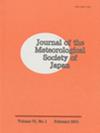日本气象厅全球和中尺度NWP系统对“hima -8”晴空辐射资料的同化
IF 1.6
4区 地球科学
Q3 METEOROLOGY & ATMOSPHERIC SCIENCES
引用次数: 16
摘要
本文报道了日本气象厅(JMA)全球和中尺度数值天气预报(NWP)系统对himawai -8晴空辐射(CSR)数据同化的影响。日本气象厅的Himawari-8和Himawari -9卫星采用了先进的Himawari成像仪(AHI),提高了在光谱、水平和时间分辨率方面的观测能力。从多功能运输卫星-2 (MTSAT-2)切换到新一代Himawari-8卫星带来的改进包括将CSR数据的水平分辨率从64公里提高到32公里,并将可用的水汽带数量从一个增加到三个。CSR产品每小时发放一次,分发给NWP社区。Himawari-8 CSR资料水平和光谱分辨率的提高,为资料同化提供了水平水汽分布和垂直剖面的新信息。在日本气象厅全球NWP系统的资料同化实验中,与单一MTSAT-2水汽通道的同化相比,Himawari-8的三个水汽带的同化显著改善了对流层湿度场,特别是对流层低层的湿度场。微波湿度测深仪的初始估计(FG)偏差统计表明水汽场有所改善,特别是在himawai -8观测区域。对“hima -8”观测区域对流层温度、湿度和风场的预报也得到了改进。利用日本气象厅中尺度NWP系统对2015年发生在日本关东-东北地区的一次灾难性强降水事件进行了资料同化实验。与MTSAT-2对应的Himawari-8 CSR的单一水汽带被同化,从而增强了干湿区水汽场的对比,并在分析中真实地反映了来自海洋的潮湿气流。这些变化也改善了中尺度模式的强降水预报。本文章由计算机程序翻译,如有差异,请以英文原文为准。
Assimilation of Himawari-8 Clear Sky Radiance Data in JMA's Global and Mesoscale NWP Systems
This article reports on the impacts of Himawari-8 Clear Sky Radiance (CSR) data assimilation in the global and mesoscale numerical weather prediction (NWP) systems of the Japan Meteorological Agency (JMA). Adoption of the Advanced Himawari Imager (AHI) on board JMA’s Himawari-8 and -9 satellites has enhanced observational capabilities in terms of spectral, horizontal, and temporal resolution. Improvements brought by the switchover from the Multi-functional Transport Satellite-2 (MTSAT-2) to the new-generation Himawari-8 satellite include an upgrade to the horizontal resolution of CSR data from 64 to 32 km and an increase in the number of available water vapor bands from one to three. CSR products are obtained every hour and distributed to the NWP community. The improved horizontal and spectral resolution of Himawari-8 CSR data provides new information on horizontal water vapor distribution and vertical profiles in data assimilation. In data assimilation experiments using JMA’s global NWP system, the assimilation of Himawari-8’s three water vapor bands significantly improved the tropospheric humidity field in analysis, especially in the lower troposphere, as compared to assimilation of the single MTSAT-2 water vapor channel. First-guess (FG) departure statistics for microwave humidity sounders indicated an improvement in the water vapor field, especially over Himawari-8 observation areas. Improved forecasting of tropospheric temperature, humidity, and wind fields for Himawari-8 observation areas was also seen. In data assimilation experiments using JMA’s mesoscale NWP system, a disastrous heavy precipitation event that took place in Japan’s Kanto-Tohoku region in 2015 was investigated. A single water vapor band of Himawari-8 CSR corresponding to MTSAT-2 was assimilated, resulting in enhanced contrast of the water vapor field between moist and dry areas, as well as a realistic representation of moist air flows from the ocean in analysis. The changes also improved mesoscale model heavy precipitation forecasts.
求助全文
通过发布文献求助,成功后即可免费获取论文全文。
去求助
来源期刊
CiteScore
6.70
自引率
16.10%
发文量
56
审稿时长
3 months
期刊介绍:
JMSJ publishes Articles and Notes and Correspondence that report novel scientific discoveries or technical developments that advance understanding in meteorology and related sciences. The journal’s broad scope includes meteorological observations, modeling, data assimilation, analyses, global and regional climate research, satellite remote sensing, chemistry and transport, and dynamic meteorology including geophysical fluid dynamics. In particular, JMSJ welcomes papers related to Asian monsoons, climate and mesoscale models, and numerical weather forecasts. Insightful and well-structured original Review Articles that describe the advances and challenges in meteorology and related sciences are also welcome.

 求助内容:
求助内容: 应助结果提醒方式:
应助结果提醒方式:


